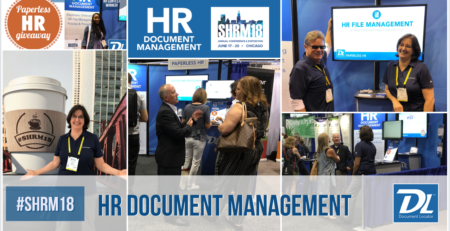Recover valuable office space by moving from filing cabinets to electronic storage in HR
A common theme we’ve been hearing this year is the elimination of storage needed for paper personnel records. Several clients have come to us with a corporate office location that is moving and the new space not having storage for HR filing cabinets. Wow, that’s cold turkey!
Support the Paperless Employee Model
It makes some sense with the cost of office space that paper files in HR would not make the cut. Companies are looking for ways to support the paperless employee model. Square footage costs are significant and paper files are inefficient. It takes more time to file paper. Although finding files can be difficult too when electronic if there is no search function available. Getting everyone to follow guidelines for naming and where to store specific files can be extremely challenging with no system in place to help.
Make Life Easier in HR by Going Paperless
What if an HR filing system made all those decisions for the team, and had effective search by content, and profiles of the document? Life just got significantly easier. Retention policies let you know when to consider getting rid of files, and reports automatically alert you for review of record candidates for retirement. You can even automate processes based on documents for consistency in approval, edit review, and various tasks. You know things are happening in a timely manner and nothing falls through the cracks!
For those David Letterman fans, here’s a top 10 list of reasons to move to an HR document management system:
10. Keep employee files in sync with HCM systems: It’s consistency that’s driven by tables already available that make it so much simpler to file records. No accidental duplicates are created. It creates an efficiency you can’t have without links.
9. Electronic forms let you have complete entry of information needed and automate processing. You can’t have a paper form start processing automatically. You save significant time on re-entry of information as the data in the form can be used immediately to tag documents as well as to start processes.
8. Retention policies are automatically followed with documents assigned as soon as they are brought into the system based on your rules. No more digging through files to find record retirement candidates, or ignoring retention policies because you don’t have time. Liability is greatly reduced when you remove records appropriately.
7. Security can control specifics of who has access to what information. Has your filing cabinet ever told you who accessed information? A complete audit log gives you all the information about who has edited, viewed, or even tried to delete a file.
6. Improve tracking for reviews and other critical dates. Throw away that spreadsheet of dates for certification, re-training & employee review reminder. You can set reminder dates on the existing documents to alert you with a tickler file that has appropriate advance notice for when you need to address. Even schedule secondary reminders to create fail safes.
5. Improve tracking of policies & procedures. How often have you pulled up an old version of a policy or had problems with an outdated procedure causing problems in production? Tracking policies also allows you to let employees read an acknowledge when there are updated policies, and you have a log of everyone who opened or viewed as well as their notation of acknowledgement.
4. Improve onboarding. One of the most paperwork intense processes can suddenly be fast and efficient without you having to chase a new hire down for that last form. Consistency again lets you know you’ve got the complete and appropriate information with little effort. And, new hires get a sense of an efficient and organized team that they’ve joined, improving retention as well.
3. No more lost files! Since you can share a link when someone needs access to a specific record, you no longer run the risk of files not being returned or lost in the transfer. Management can have appropriate access without needing to take files anywhere. If a copy needs to be shared with an employee or other appropriate contact, it’s a simple right click to send.
2. Find things when you need them. Imagine an audit where you just type in a few key words to access the right files, copy a link and create a collection of documents for the auditor to review. No more digging through cabinets, getting papercuts and photocopying for review. Fulfilling employee requests for information is a snap.
And the number 1 reason people are looking at document management for employee files?
To get rid of the paper! Paper costs money – in the raw cost, the time consuming way it needs to be processed, and in the incredible amount of space it can eat up. Estimates have shown that when all the associated costs of paper filing are considered, including everything from the cost of office square footage to the cost of paper itself, it can add up to as much as $2,000 per filing cabinet annually.
So, even before you move offices… can you benefit from recovering that lost space in your office?
To learn more about ColumbiaSoft and the benefits of implementing Document Management Software for your company request a demo today.






